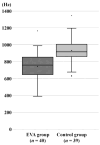Diagnosis of Enlarged Vestibular Aqueduct Using Wideband Tympanometry
- PMID: 39518739
- PMCID: PMC11546652
- DOI: 10.3390/jcm13216602
Diagnosis of Enlarged Vestibular Aqueduct Using Wideband Tympanometry
Abstract
Background: Wideband tympanometry (WBT) has the potential to distinguish various mechanical middle ear and inner ear pathologies noninvasively. This study investigated the diagnostic value of WBT in the diagnosis of enlarged vestibular aqueduct (EVA). Methods: The absorbance and resonance frequency (RF) of patients with EVA (40 ears, 25 patients) and matched population controls (39 ears, 28 subjects) were compared, alongside receiver operating characteristic (ROC) analysis. Correlations between VA width and RF were also examined. Results: Patients with EVA had higher absorbance at low frequencies (226-917 Hz) and lower absorbance at high frequencies (2520-4896 Hz) compared to controls. The RF of the EVA group was significantly lower versus controls (751 [391-1165] vs. 933 [628-1346] Hz). The ROC analysis revealed area under the curve values of 0.771 and 0.801, respectively, for absorbance and RF. RF had a sensitivity, specificity, positive predictive value, and negative predictive value of 74.4%, 82.5%, 76.7%, and 80.6%, respectively, for diagnosing EVA. In the EVA group, the VA midpoint width (r = -0.334) and VA petrous width (r = -0.402) both significantly correlated with RF. Conclusions: Our findings support the utility of WBT for diagnosing EVA, with RF as the optimal index used.
Keywords: ROC analysis; absorbance; diagnosis; enlarged vestibular aqueduct; resonance frequency; temporal bone computed tomography; wideband tympanometry.
Conflict of interest statement
The authors declare no conflicts of interest.
Figures






References
Grants and funding
LinkOut - more resources
Full Text Sources

